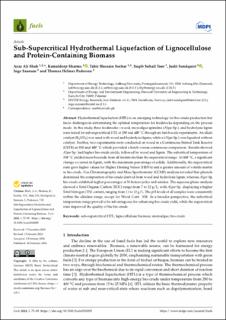| dc.description.abstract | first_pagesettingsOrder Article Reprints Open AccessArticle Sub-Supercritical Hydrothermal Liquefaction of Lignocellulose and Protein-Containing Biomass by Ayaz Ali Shah 1,2,*,Kamaldeep Sharma 1ORCID,Tahir Hussain Seehar 1,2,Saqib Sohail Toor 1,Judit Sandquist 3ORCID,Inge Saanum 3 andThomas Helmer Pedersen 1 1 Department of Energy Technology, Aalborg University, Pontoppidanstræde 111, 9220 Aalborg Øst, Denmark 2 Department of Energy and Environment Engineering, Dawood University of Engineering & Technology, Karachi City 74800, Pakistan 3 SINTEF Energy Research, Sem Sælands vei 11, 7034 Trondheim, Norway * Author to whom correspondence should be addressed. Fuels 2024, 5(1), 75-89; https://doi.org/10.3390/fuels5010005 Submission received: 7 December 2023 / Revised: 15 January 2024 / Accepted: 3 February 2024 / Published: 26 February 2024 Downloadkeyboard_arrow_down Browse Figures Versions Notes Abstract Hydrothermal liquefaction (HTL) is an emerging technology for bio-crude production but faces challenges in determining the optimal temperature for feedstocks depending on the process mode. In this study, three feedstocks—wood, microalgae spirulina (Algae Sp.), and hydrolysis lignin were tested for sub-supercritical HTL at 350 and 400 °C through six batch-scale experiments. An alkali catalyst (K2CO3) was used with wood and hydrolysis lignin, while e (Algae Sp.) was liquefied without catalyst. Further, two experiments were conducted on wood in a Continuous Stirred Tank Reactor (CSTR) at 350 and 400 °C which provided a batch versus continuous comparison. Results showed Algae Sp. had higher bio-crude yields, followed by wood and lignin. The subcritical temperature of 350 °C yielded more biocrude from all feedstocks than the supercritical range. At 400 °C, a significant change occurred in lignin, with the maximum percentage of solids. Additionally, the supercritical state gave higher values for Higher Heating Values (HHVs) and a greater amount of volatile matter in bio-crude. Gas Chromatography and Mass Spectrometry (GCMS) analysis revealed that phenols dominated the composition of bio-crude derived from wood and hydrolysis lignin, whereas Algae Sp. bio-crude exhibited higher percentages of N-heterocycles and amides. The aqueous phase analysis showed a Total Organic Carbon (TOC) range from 7 to 22 g/L, with Algae Sp. displaying a higher Total Nitrogen (TN) content, ranging from 11 to 13 g/L. The pH levels of all samples were consistently within the alkaline range, except for Wood Cont. 350. In a broader perspective, the subcritical temperature range proved to be advantageous for enhancing bio-crude yield, while the supercritical state improved the quality of the bio-crude. Keywords: sub-supercritical HTL; lignocellulosic biomass; microalgae; bio-crude | en_US |

